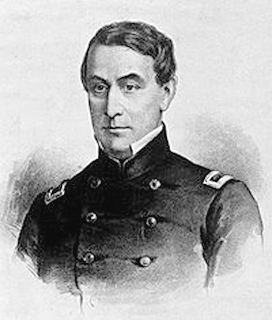|
At Fort Sumter
Artillery specialist Robert Anderson
saw the war started by his pupil
Robert Anderson could be labeled as one who did his job too well.
Some two months shy of his 57th birthday, the Union major who was America’s most knowledgable artillery authority was fired upon by his pupil, Confederate Brig. Gen. P.G.T. Beauregard.
The time was April 12, 1861. The site was Fort Sumter, S.C. The event was the beginning of the U.S. Civil War.
Anderson, who was born near Louisville, Ky., was considering retirement after 35 years in the army when he was ordered to assume command at Fort Moultrie, S.C., in November 1860. In December, he transferred the Union garrison from the dilapidated Fort Moultrie to the unfinished, but more defensible, Fort Sumter.
Beauregard, who was trained by Anderson at West Point, opened fire early on the morning of April 12. But the pentagonal fort of brick construction suffered no major damage during the 34-hour bombardment. No one was killed during the battle, but Anderson was forced to surrender when his food and ammunition were depleted.
Anderson's actions at Fort Sumter made him an immediate national hero. He was promoted to brigadier general effective May 15. Anderson took the fort's 33-star flag with him to New York City where he participated in a patriotic rally that is thought to have been the largest public gathering in North America up to that time. Anderson then went on a highly-successful recruiting tour of the North.
The U.S. Military Academy graduate (1825) received his initial commission as a second lieutenant in the 2nd U.S. Artillery. He served in the Black Hawk War as a colonel of Illinois volunteers and had the distinction of twice mustering Capt. Abraham Lincoln in and out of army service. He served in the Second Seminole War and, as an assistant adjutant general on the staff of Gen. Winfield Scott, was severely wounded at Molino del Rey in the Mexican War. Promoted to major, he assumed command of the 1st U.S. Artillery in 1857. In 1839, he had authored “Instruction for Field Artillery, Horse and Foot.”
Anderson was considered pro-southern and a defender of slavery and was married to the daughter of a wealthy Georgia slave owner. However, despite his personal sympathies, his rigid concept of duty was instrumental in his defense of Fort Sumter. Ironically, Anderson was steadfast in his desire to not start a war.
Following the Surrender at Appomattox, Anderson returned four years after having lowered his flag in surrender and raised it in triumph over the recaptured Fort Sumter. That also was the same evening, April 14, 1865, that President Lincoln was assassinated. Anderson, now a brigadier general, was appointed commander of the Department of Kentucky in May 1861. Three months later, the department was renamed the Department of the Cumberland.
When Confederate Gen. Leonidas Polk occupied Kentucky at Columbus on the Mississippi, Anderson transferred his headquarters from Cincinnati to Louisville and placed Gen. George H. Thomas in charge of Camp Dick Robinson (Ky.), the nation’s first modern basic training camp.
A notable post-war achievement of Anderson took place in 1869 when he visited Braintree, Mass., to discuss the future of the U.S. Army with the founder of the United States Military Academy, Major Gen. Sylvanus Thayer. An outcome of that visit was establishment of the Military Academy's Association of Graduates.
Anderson died in Nice, France in 1871 at age 66 and is buried in the West Point Cemetery.
|
|
 |
|









